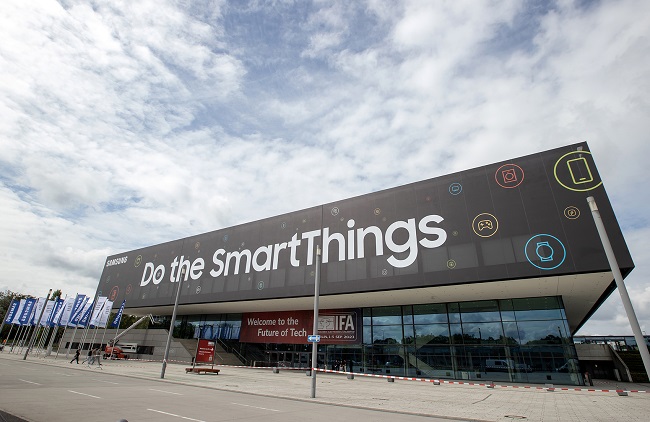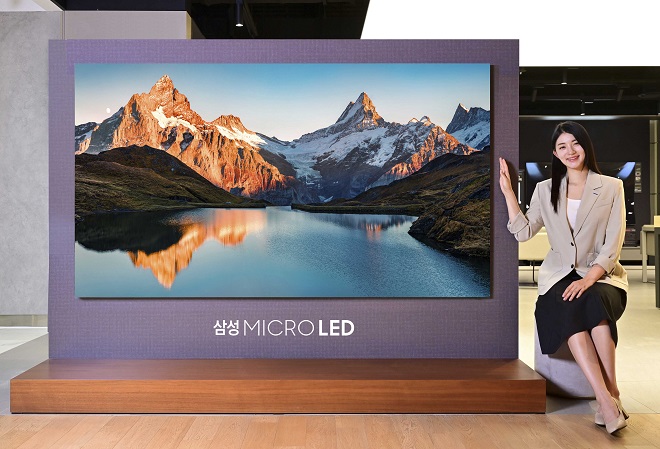SEOUL, Sept. 5 (Korea Bizwire) — In the global premium TV market, Samsung Electronics Co. and LG Electronics Inc., two major players, have long engaged in a competitive battle for supremacy at IFA, the world’s largest consumer electronics and home appliances trade show, widely seen as the annual “TV battleground.”
Their rivalry has manifested in the introduction of groundbreaking technologies such as the first 4K resolution and organic light-emitting diode (OLED) TVs.
However, this year’s IFA event marked a departure from the traditional focus on TVs. Instead, it was characterized by the emergence of novel forms of visual display, including portable products and beam projection.
This strategic shift appears to be a response to the growing presence of Chinese competitors in the market.
Chinese vendors made their presence felt at the show, with extensive displays showcasing large TV lineups, particularly targeting the European market due to North American market restrictions stemming from U.S. sanctions.
Brands like Konka and Changhong emphasized mini-LED, micro-LED, and OLED TVs, directly challenging the flagship TV offerings of Samsung and LG, respectively.
TCL, the largest among the Chinese vendors, prominently showcased its QD MiniLED TVs, which bear similarities to Samsung’s Quantum Dot (QD) OLED displays.
Notably, Chinese companies introduced numerous 100-inch and larger TVs, a category absent from Samsung Electronics and LG Electronics’ flagship lineups.
This aligns with the global TV market trend favoring ultra-large and high-end products.
TCL even extended its QD MiniLED TV to an impressive 115 inches, surpassing Samsung’s offerings. Furthermore, its MicroLED TVs exceeded the size of Samsung’s at a remarkable 163 inches.
Samsung and LG recognize a considerable technology gap in the ultra-large and premium segments and are committed to maintaining their market leadership.
They’re intent on exploring new avenues within this space, with the mantra of “bigger is better.”
They aim to disrupt the stagnant TV market with highly profitable super-sized products, leveraging Samsung Electronics’ unique expertise to deliver crisper, cleaner pictures.
Chung Kang-il, vice president and head of Samsung visual display division’s future planning group, asserted that the demand for ultra-large TVs resonates with the human inclination toward larger experiences.
He affirmed the company’s dedication to strengthening its market dominance in the premium ultra-large category.

The signage of the City Cube Berlin venue for Samsung Electronics Co.’s IFA exhibition says “Do the SmartThings” on Aug. 31, 2023, in this photo provided by the company.
Despite an overall anticipated 5.8 percent year-on-year contraction in the global TV market to US$96.5 billion due to the COVID-19 pandemic, ultra-large and premium products continue to thrive.
Chinese companies like TCL and Hisense have been gaining ground by volume, ranking second and third globally.
However, Samsung and LG maintain a strong revenue share thanks to their substantial sales of high-priced ultra-large and premium TVs.
Samsung’s product lineup includes three 98-inch TVs, including the Neo QLED 8K, Neo QLED, and QLED models, introduced in July.
Regarding the Chinese consumer electronics industry’s efforts to catch up, Chung remains confident in Samsung’s unique technology.
He believes that the Neo QLED’s use of mini-LEDs as a light source, similar to Chinese technology, still differentiates itself by delivering sharper and cleaner images.
LG has adopted a similar strategy, favoring larger OLED TVs over smaller ones.
Baik Seon-pill, vice president and head of LG’s TV product planning division, emphasized the shift towards larger and more expensive products as the TV market’s growth potential remains constrained.

Visitors look around the LG Sustainable Village at IFA 2023 in Berlin on Sept. 1, 2023, in this photo provided by the company.
Nevertheless, there are differing views between the two companies regarding the 100-inch and larger TV market.
Samsung aims to strengthen its leadership in the ultra-large segment by exploring this territory, while LG perceives global demand for such TVs as limited.
Both companies face the challenge of commercializing micro-LED technology, considered as the next generation to replace OLED.
These displays use even smaller components than mini-LEDs, with the complexity of embedding tiny LED elements individually on a substrate, posing challenges in terms of pricing and mass production.
Samsung’s 89-inch micro-LED TV and LG’s 136-inch “LG Magnit All-in-One” both come with hefty price tags exceeding 100 million won (US$75,380).
Baek anticipates that the TV market will only significantly expand once prices fall below 10 million won. Consequently, the commercialization of micro-LED displays is expected to take at least five years.
Kevin Lee (kevinlee@koreabizwire.com)








